CONTENTS
TRYPILLYA CULTURE PROTO-CITIES:
HISTORY OF DISCOVERY AND INVESTIGATIONS
©M.Yu.Videiko
Published: ³äåéêî Ì.Þ. Òðèï³ëüñüê³ ïðîòîì³ñòà. ²ñòîð³ÿ äîñë³äæåíü.
Êè¿â, 2002; ñ.103-125: (Videiko M.Yu. Trypillya culture proto-cities. History
of investigations. Kiev,2002, p.103-125).
Civilisation of Old Europe with its fortified settlements, temples
and developed religion flourished in Neolithic and Copper Age
. From the end of VI till the beginning of III Mill. B.C. Tripillya – Cucuteni
culture was the Eastern border of Old Europe. When in the second part of
V Mil. B.C. civilisations of Vinca and Karanovo dissapeared,
Tripillya for 1000 years the Old Europe Civilisation traditions conti-nied.
We think, that Tripillya – culture proto – cities were the largest settlements
in Europe 6000 – 5000 years ago. This book is about the history of their
discovery an investigations.
On beginning of 70-th years of ÕÕth century two events happened, which
played an important role in further researches of Trypillya culture.
First from them - this is opening of Trypillya proto - cities, giants settlements-
of Copper Age at Cherkassy domain. This event meant, that at the
end of ÕÕth century, in the center of Europe, in Ukraine, opened unknown
to science proto - urban civilization, contemporary with analogous phenomenons
at Ancient East. Open-ing History and study Trypillya proto - cities in
sort reminds of history of all Trypillya culture discovering: remains of
ancient settlements were discovered a long while ago, but it were some
time necessary and efforts in ordered to comprhectaresend, what was found.
A Second event is associated with first and imprescriptible from it.
In order to find this settlements the new (for archaeology of Trypillya
culture) research methods were used: aerial and magnetic survey.
Own these methods were not in archaeology new. At all-
then aerial survey used already on beginning of twentieth age,
and magnetic survey in archaeology from end 50- years, and in Trypillya
archaeology - from beginning of 60-th years of XXth century.
The new was their complex combination with some traditional
methods of archaeology.
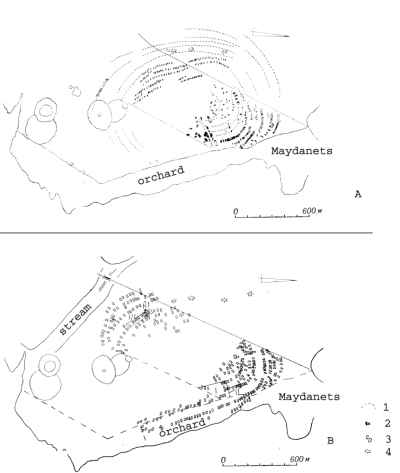
Plans of the selttlement near Maydanets : A – aerial survey map (after
K.V.Shyshkin); B – remains of settlement after field prospecting (after
M.Shmaglij, K.Zinkovsky and V.Dudkin). Investigations of 1971 – 1972.
1,2,3 – remains of dwellings; 4- burial mounds from Bronze Age.
Trypillya proto - cities were discovered by Ê. Shyshkin, military
topographer, a specialist in aerial identification. Learning
the photos of different Ukraine regions, especially from Cherkassy
domain territory, he found the traces of the large settlements, which
were unknown to archaeologists.
In 1964 K.Shyshkin together with V. Stefanovich inspected fields
near the village Vilkhovets, under Zvenyhorodka, where had
view of one of such locations, which appeared by settlement of Trypillya
culture, greater for all of known by then is 110 hectares.
Then K.Shyshkin analyzed 11 places, already
described by T.Passek, a place of which was well definited.
The results were shocking: Maydanetske had area 270 hectares, Kosenivka
70 hectares, Sushkivka 27 hectares, Chychyrkozivka 50 hectares,
P'yanioshkove - 60 hectares. After aerialphoto's analysis was picked
out over 100 settlements, in V.Stefanovych list were only 30 from
them, among new - giants: Tallyanky with square near
450 hectares, Dobrovody - 250 hectares,
Nebelivka - 300 hectares. On photos were read the large
circle structures, that broke down under separate dwellings, streets and
quarters, ditches traces. The Settlements Trypillya culture had size
and appearance of cities (Øèøêií, 1973).
Usually, majority of mentioned above settlements were known to archaeologists
before. Some of them in Õ²Õ end is on ÕÕ ctnturies beginning were explored
! These excavations can be con-sidered, as prehistory of proto -
cities studying, cumulative material today one can be entangled for development
of new problems. But scientific research to phenomenon conducts only last
thirty years.
We shall describe here a history of field archaeological in-vestigations
and arheometry works, than - problem of historiography.
THE FIELD INVESTIGATIONS
PREHISTORY: 1891 - 1970.
In 1891 year a famous Ukrainian historian V. Antonovich to-gether with
Ch.Zborovsky saw out the excavations of settlement by Krinichki
village on Podillya. Area of this settlement composed near
50 hectares. Materials from these explorations today are kept into
St.Petersburg, in Hermitage. If to begin history of the large
set-tlements of Trypillya culture archaeological excavations, then it has
now, so-and-so, over hundred years.
In 1902- 1903 yy. E.Shtern dug out the oddments of eight dwellings
into Petreny by Belcy in Moldova. In second ÕÕ half a. stood it's known,
that this one of most of Trypillya culture settle-ments in Moldova - by
30 hectares. Neolithic sites from this region were included by this author
to Danube cultures circle and borne to pre - Mycenae
period , dated by third millennium BC. It is inter-esting,
that a dating this is held out factually to beginning 60- years of
XX century, while appeared the first absolute isotope dates for Trypillya
- Cucuteni culture.
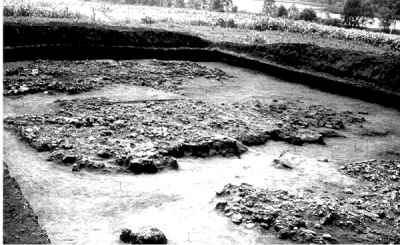
Remains of burnt dwellings. Maydanets’ke, Cherkassy domain.
Excavated by M.Shmaglij and M.Videiko, 1988.
Excavations of V.Khvoika and E.Shtern cause bending to study of Trypillya
culture in Russia. A Emperor archaeological com-mission committed to famous
archaeologist O.Spicyn to see out the excavations at Kolodyste (now Cherkassy
domain), where before that Vasyl Domanyts'ky opened "
threshing-floors" - places, covered by the burnt clay(Äîìàíèöêèé,1899,
Ñïèöûí, 1904). So was been accorded first data about building and cultural
belonging of Trypillya culture settlements - giants in country between
South Bug and Dni-pro.
Considerable works by Popudya and villages and P'yanioshkove
near Uman saw out in 1911 ð. Marian Himner ( Himner,
1933). It dug out the big areas on this settlements, that represented
the different development phases of Trypillya culture (²-²² and Ѳ beginning
) in this region.
In 1916 ð. V.Kozlovs'ka excavated some dwellings at Sushkivka
, also at this region (Êîçëîâñüêà, 1926). Already in
this time the investigated remains was accounted special type of
Trypil-lya culture, by basic distinction of which a presence
was of painted pottery pottery in considerable amount. Materials
from these exca-vations great while remained whether by not one source
for study of Trypillya culture in country between South Bug and Dnipro.
In 1924 - 1927 yy. Petro Kurinny digs out settlement
by Tomashivka (real square near 250 hectares) at Uman district, (Êóð³ííèé,
1925. 1926à; 1926á). In 1927 B.Bezvenglins'ky for the
first time dug out settlement near Maydanets. To regret,
materials from these excavations lost.
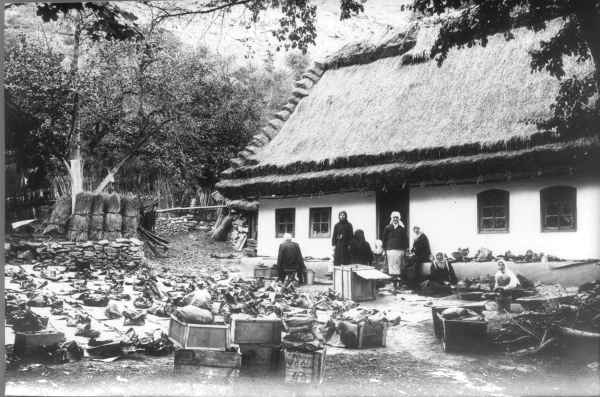
Pottery from Tripillya settlement near Stina, after excavations
by Sergej Gamchenko at 1929.
S.S.Gamchenko at 1929 opened and M.L.Makarevich in 1958- 60 yy.
Continied investigations of an settlement of late stage of Trypillya
culture near Stina village on Dniste. Here an interesting complex of painted
pottery, ceramics with impresses to textile fabrics were found. This Ѳ
stage settlement had area into 1 square km., near a row of small settlements
was found( Ìàêàðåâè÷, 1958). Vale-ria Kozlovs'ka continued excavations
near Sushkivka at 1926 (Êîçëîâñüêà, 1928, 1926á), and in 1936 opened
researches of set-tlement by Volodymyrivka on Synyukha
river(Ïàññåê, 1941). At that time a painted dwelling Model was
found here. Excavations at Volodymyrivka continued T.Passek in 1945 and
1946. Was not only inquired into separate dwellings, but composed an instruction
plan, on which was drifted to 200 dwellings (Ïàññåê, 1947, 1949).
It was first, and to beginning 70 years - the singular
plan of big Trypillya settlement, formed
exceptionally for data of visual researches without use of technical methods.
Interestingly, that later it was in whole endorsed by K.Shyshkin by identification
of aerial-photo(Øèøê³í, 1985).

Plan of the large Trypillya settlement near Volodymyrivka (after
T.S.Passek, 1949)
In 60-and 70 years a considerable scope of investigative works was executed
by expedition under guidance O.Tsvek, which learned the
instructions middle of Trypillya culture from stages ²,
²/²², and BII near Vesely Kut (150 hectares), Myropillya (200 hec-tares),
Harbuzyn (70 hectares) and other places (Öâåê,
1972,1974,1975,1976, 1978,1980à,1980á,1980â). By Result of
these researches stood generalizing description of developed phase of Trypillya
culture between South Bug and Dnipro(Öâåê, 1987).
Considerable payment into archaeological inspections of Trypillya
culture at Uman district into 60 - 70th years brought in the local
naturalists V.Stefanovich and H.Hraban, who found and charted about 130
settlements (Õðàáàí, 1961; 1963; Ñòåôàíîâè÷, 1968).
THE NEW PERIOD OF INVESTIGATIONS:
1971 - 1993.
Over 250 instructions were interpreted by K.Shyshkin,
which, associated, on his thought with Trypillya culture (Øèøê³í,
1973, fig. 1). About 15 years he worked also
over plans of sepa-rate settlements. Published today 27 such
plans and their variants (Øèøê³í,1973,1985).
Following researches bore out any amount of elements from these identifications
( Äóäêèí,1978, Øìàãëèé,1980, Êðóö, 1989), however together from that under
time of field researches appeared, that to map of Trypillya
culture settlements at Uman region K.Shyshkin settlements trace to
treat critically. Works of K.Shyshkin came into notice of archaeologists,
and already in 1970 - 1971 ð. S.Bibikov, M.Shmaglij , M.Shtiglic
saw out settlements, of settlements definite by it (Øòèãëèö, 1971).
In 1971 y.
on Maydanets settlement worked Trypillya party from Institute of
Archaeology from Kyiv under the guidance of M.Shmaglij and from 1972 -
Trypillya Complex Expedition (TCE). Exclusive of visual inspection here
will be pressed into the service of geophysical magnetic survey, the results
of which audited by exca-vations. So was developed a new methods
and broken the ice to complex study of Tripillya settlements (Øìàãë³é,
Äóäê³í, 3iíüêîâñüêèé, 1973). Excavations in Maydanets
continued to 1991 (Øìàãë³é, ³äåéêî, 1991). In
1972 - 1974 yy. By V.Dudkin skimmed a magnetic settlement plan (Äóäêèí,
1978).
In 1981 set to its work a Trypillya expedition under guidance of I.Artemenko.
By Her aim was research of big Tripillya settle-ments and barrows on their
territory. For hours together investi-gated a few instructions.
In 1981 - 1999 O.Kruts explored settle-ment by area 450
hectares by Tallyanki (Êðóö, Ðûæîâ, 1984: Êðóö, 1986; 1989; 1990.
1991 but oth.). Ò. Ã. Ìîâøà conducted the excavations
on settlements by Dobrovody and Kosenivka vil-lages (Ìîâøà,
1982, 1983, 1984à. 1984á). O.Tsvek continued excavations
at Vesely Kut and Onopriyivka (Öâåê, 1982; 1983; 1987;
1990). In 1984 y. was gone on inspection
in 30 - km terri-tory around around Maydanets (Øìàãë³é, ³äåéêî,
1987; 1991).
I.Artemenko inquired into barrows on settlements territory in Tallyanki
and Dobrovody, exclusive of that two barrows was dug out in Maydanets (Øìàãëèé,
Âèäåéêî, 1987, 1994). All for nine ex-istence years of Trypillya
expedition her collaborators dug out about 70 different objects
type on enumerated settlements. Exclusive of that was gone
on with stowage of plans for data of magnetic survey - fully
skimmed Tallyanki, Pischana, partially -
Kosenivka.
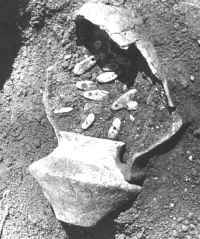
“Treasure” – pot with bone pedants , under the remains of burnt dwelling
found . Maydanets’ke, Cherkassy domain. Excavated at 1979.
Exclusive of excavations were seen out inspections,
stow-age of map of Tripillya sites on periphery of big settlements.
Con-sequently, 17 settlements were inspected by Maydanets
detach-ment in 1981-1985 (Øìàãëèé, Âèäåéêî, 1981, 1982,1985,
1992).Tallyanki detachment inspected the settlements
in a little regions of Cherkassy and Kirovograd domains, saw out some exca-vations
in Moshuriv and Pischana(Êðóö, Ðûæîâ 1982, 1984, 1985).
In Uman region saw out inspections T.Movsha(Ìîâøà, 1983, 1984à).
O.Tsvek found out and saw out research on settlements in pool of Velyka
Vys river: Andriyivka, Lekarevo and other(Öâåê,1988). In 1990
where found flint mine and workshops of Trypillya culture near Korobchyne
at Kirovograd domain (Öâåê, 1991à).
In 1990 O.Kruts and author explored remains of the seven
dwellings an Tal'ne-2 settlement, in 5 km from Maydanets (Êðóö,
Âèäåéêî, 1991). Beside Tal'ne is opened still one, synchronous
to it, a small settlement is Tal'ne - 3(³äåéêî, 1991à). These excava-tions
gave informations as for planning, building and disposition
of small settlements composing,probably, periphery of
big Tripillya centres like Tallyanky and Maydanets.
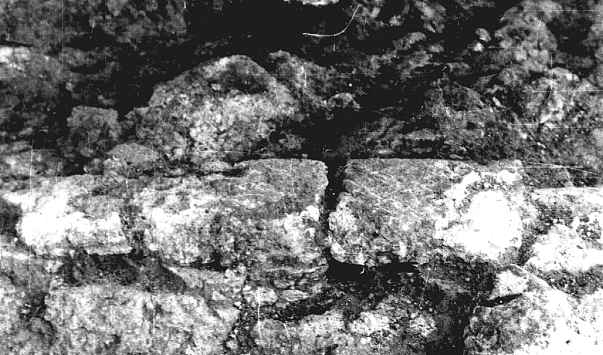
Remains of clay threshold at burnt dwelling . Maydanets’ke,
Cherkassy domain. Excavated by M.Shmaglij and M.Videiko, 1986.
Realization of scientific sense of these researches in process of time
brought over archaeologists to taking idea (by the way, whether for the
first time for research history of Trypillya culture) of special
scientific forum for discussion of problem. In 1990 - 1991 yy. two field
seminars to study of settlements - the giants of Trypillya culture was
devoted. Participants of field seminars had a possibility to acquaint with
excavations in Maydanets and Tallyanky, Onopriy-ivka and Tal'ne -
2 and to discuss a wide circle of questions,
as-sociated with house-building, planning,
economy etc. Was lined the study sums of this phenomenon of old history.
THE LAST INVESTIGATIONS :
1993 - 2001.
Into last seven years investigations essentially grew short. Into this
period with interruptions continued the excavations into Tallyanky, where
amount of explored buildings reached on 2000 year 27 and different parts
of settlement were explored (Êðóö, Ðèæîâ, 1997; Êðóö, Êîëåñí³êîâ, ×àáàíþê,
Øóìîâà 1998; Êðóö, Êîðâèí -Ïèîòðîâñêèé, ×àáàíþê, 2001). Materials
from this site now prepared to edition.
Into 1993 M.Videiko explored remains of two dwellings odd-ments on
Vilkhovets settlement of Kosenivka type, phase Trypillya CII(³äåéêî, 1997).
According to isotope dates, it was one of the last Trypillya proto - cities,
burnt near 2900/2750 BC.
From 1997 E.Ovchinnicov inspected some large settlements in regions,
closer to Dnipro. Excavations give evidences, that they are from BII and
CI stages of Trypillya and belonged to Kaniv group of Trypillya culture.
Among them - Vilshana - 1 (30 hectares), Voro-novka 1 (15 hectares), Vilshana
- 2, Voronovka - 2, Petryky, Kvitky - II and Sukhiny (20 hectares), Kvitky
- III (25 hectares) (Îâ÷èííèêîâ, 1999, ñ.132 - 136). Then E.Ovchinnicov
and D.Chornovil excavated remains of dwellings at Nezamozhnyk settlement
(settled are near 30 hectares)(Îâ÷èííèêîâ,×åðíîâîë, 1999). They were similar
to dwellings, explored at Tallyanky and Maydanets. E.Ovchinnikov in-spected
also some another large settlements at this region - Ksaverovo (30 hectares),
stage CI or BII; Gorodysche - 2 (near 15 hectares) stage CI; Mliev - 1
(near 50 hectares), CI; and some small settlements (4 - 7 hectares), situated
at their periphery (Îâ÷èííèêîâ,Íàçàðîâ,2001, ñ.170 - 182).
At Zelena Dibrova settlement E.Ovchinnikov explored re-mains of dwellings
and pottery workshop (Oâ÷èííèêîâ,2001).So in this period at country between
South Bug and Dnipro were two local groups of Trypillya culture, who built
large settlements - protocities. But at eastern regions the largest settlements
were only 30 - 50 hectares.
STUDYING OF TRYPILLYA SETTLEMENTS
PLANNING.
Study of Trypillya Cucuteni settlements planning from their opening
and first steps of scientific study was one of major investi-gative
problems. On beginning in order of archaeologists were only the traditional
methods are excavations, collection of lifting material, digging a prospect-hole,
buildings remains search by the medium of metallic probes. However
scales of open instructions, their number compelled to search and to employ
aerial photography and magnetic survey. From beginning of their application
all for 30 years amount of settlements plans, accessible
today to archaeologists enlarged. Trypillya - Cucuteni was allegedly
reopened to world - now already not only as one of most bright cultures
of Copper Age, but and as one of first Europe civilizations.
Aerial photography. By superiority of given method there is a
possibility to overcome from height archaeological
objects considerable for area, to orientate in their disposition,
dimensions, planning peculiarities, etc. Following and possibility-
of particular importance to see on photos the objects, which lie
in earth on depths to 1 metre. Last identified on photographies due
to different soil hues and vegetation. Attached to ploughing
on fields soil relocates from below top, and on surface came clods
of burnt clay from re-mains of Tripillya dwellings. Signs
of old settlements loud also by reason of soils
reaction and vegetation on building oddments and cultural layer
of settlement. Over remainders of Tripillya
build-ings congested soil with lesser humus contents weighed with ambi-ent
area. So happened a tonal difference by grey
locality back-ground general, and rows of dwellings, which give white tone
on pied photo. Exclusive of that to exposure of buildings assist
microrelief, erosions water and windy, the chemical changes
and humidity level reverberate on vegetation state in archaeological
instruction place. Are Reinforced by object-glass optics of the photographic
camera they allow at first to pick out as general fig. so and separate
where- thawed- up to separate buildings (Øèøê³í, 1985, ñ.72).
After ploughing the rows of dwellings on settlement visibly it been
not that from aircraft, and from tree, from barrow embankment, or contrary
beam shore whether nearest height. Namely so-and-so Ê.Shyshkin in 1964
y. checked out its impressions from identification of Trypillya culture
settlement by Vilkhovets village: looked out on neighbouring
hump and on ploughed tillage caught sight of part of settlement.
Only so, according to his stories, resorted to imagine,
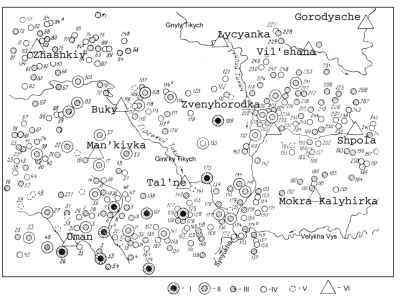
Aerial survey map of Tripillya settlements at Cherkassy domain (after
K.V.Shyshkin): I – well seen, confirmed by field survey; II –very well
seen; III – well seen; IV – bad; V –very bad seen.VI – contemporary cities.
5a-Dobrovody; 7- Kosenivka; 55- Sushkivka;125 – Maydanets’ke; 106 – Vilk-hovets’;
131 – Tal’yanky; 232 – Chychyrkozivka; 175 – Glybochok.
as is to look identical settlement
on aerialphoto, namely: alter-nation of concentric figures (rows
of dwellings)of tones dark and light attached to lustily weak contrast.
On aerial photography of the ancient settlement near May-danets
K.Shyshkin emplaced of his disposition- western
village neighbourhood, on to cape, limited by flood-lands
of Tallyanky and nameless brook, dimensions - for about
1500õ2000 m. Was set also planning is in ellipses appearance, written
into one into other. Was loudly kurhan mounds on settlement
territory and also separate dwellings. It's known three Maydanets aerialphotos
identi-fication variants, carried out by K.Shyshkin.
However main problem was in that into K.Shyshkin
open-ing do not believe archaeologists, which had its
prettily existing looks on that, which is able and to which a Trypillya
culture settle-ment go on with you. Correspondence on
the subject of settle-ments-giants opening between K.Shyshkin and Archaeology
Institute guidance in Kiev, and later - with M.Shmaglij protractedly
a little years, while into 1971 y. successfully- ñÿ to move
business from place. Maydanets êèé reconnaissance detachment
drove out into field at autumn of 1971, being in dark, that on
instruction already had been the colleagues from Moscow.
A Moscow Archaeology In-stitute detached for data verification
about gigantic housing ar-chaeologist M.Shtiglic
(Øò³ãë³ö,1971). It had view of field, but nor to lead, nor to disavow
K.Shyshkin identifications M.Shtiglic inspection does not be able, showing
helplessness of traditional archaeology in
front of carriage of this problem.(Øòèãëèö, 1972)
The Kiev archaeologists from the first went towards other by dint of,
which brought over them to invention, namely to
invention of "complex research methods of Tripillya
settlements". Usually, was pressed into the service
of possibilities of archaeological in-spection- on plan by
the medium of theodolite was drifted over 400 spot of burnt
clay from Tripillya dwellings, damaged by plough-ing - but this was only
one of five fields, which occupied a settle-ment
area.
Magnetic survey. In summer 1971 V.Dudkin conducted geophysical survey
at Maydanets. For magnetic survey were used Ì-17, Ì-23 and Ì-27 magnetometers.
For the first time was allotted task to do a full plan of such settlement,
which was finished in Autumn of 1974. A survey area composed by 180
hectares, and amount of ex-pressed anomalies from dwellings and other
objects -1575 (Äóäêèí, 1978).
In 1983-1986 years it brushed works up on settlements-giants,
subtracting 232 hectares, accessible for researches on set-tlement by ñ.Tallyanky
in Cherkassy domain. General settlement area for given aerialphoto
composes 450 hectares.
Into 70-80th years went magnetic survey on some settle-ments
was provided by G.Zagnij, which took a search of separate dwellings on
different settlements - Vesely Kut, Myropillya, plans of Pischana and Talne
- 2.
In 1993 - 1994 by magnetic survey (program carried under guidance of
V.Dudkin) were created plans of proto - cities at Yam-pil, Yatranivka,
Glybochok, Vilkhovets (Cherkassy domain), Fedorivka and large Trypillya
A settlement Mogyl'na - III (Kirovohrad domain).
DISCUSSION ABOUT TRIPILLYA - CULTURE
LARGE SETTLEMENTS.
It started long before investigations of K.Shyshkin and exca-vations
at Maydanets by M.Shmaglij. Mentioned above settlement near Volodymyrivka,
excavated at 1936 - 1946 was interpreted by T.Passel, as a "big tribal
settlement" (Passek, 1949). However, still in 1947 V.Petrov,
reference to considerable dimensions of this set-tlement, agreed
that "If on thens, then one can quite probably be reiterated,
that on given stage a village already began outgrow into
town. Than Volodymyrivka was interpreted at 1965 by S.Bibikov as
"an intertribal center, based on fratrial structures" (Áèáèêîâá 1965).
After beginning of excavations in Maydanets
at the begin-ning of 70-th years by his investigators was said
thesis about exis-tence of proto - cities in Eneolithic of East Europe
(Øìàãë³é, Äóäê³í, dzíüêîâñüêèé, 1973).
Such determination does not win to oneself adherents into then.
In further appearance of big settle-ments considered on plant-louse of
global historic processes of cop-per age. V.Danilenko
and M.Shmaglij establish into 1975 the "ecological " approach to
this phenomenon, considering Eneolithic, as time "of
violation of equilibrium between society and ambient envi-ronment. "
In 70 - on beginning 80-th M.Shmaglij gave a row
of de-scriptions for big settlements.
Consequently, they valued as " predecessors
of ancient European towns", agrarian in base, but with
some morphological and social signs of urbanization of
public life, or populated locality of proto - city type.
Myself urbanization process attached to this M.Shmaglij does not think
completed. By expression of urbanization process, on his thought,
were the plan-ning peculiarities, which bears witness
to forming the towns of an-cient type with defensive walls,
Acropolis and Agorae in. In first paleo - demographical reconstructions
became deductions about possible amount of Maydanets population: at first
10000-15000. (Øìàãëèé, Äóäêèí, Çèíüêîâñêèé, 1975), than
20000 - 24000 peoples. (Øìàãëèé Í. Ì., 1980,
1982, ). Appearance of greater amount of data about building,
dwellings types allowed to look through these reconstructions
into ciphers lowering side to 6000 - 9000 (Øìàãëié Ì.
Ì., Âiäåéêî Ì. Þ., 1987), that nearer to V.Kruts estimation
near 8200 persons(Êðóö,1989 ). Authors under-stood,
usually, relativity of its computations, looking over them in tie
with expansion of archaeological data base.
M.Shmaglij characterized Maydanets not only as proto - city,
but as centre of pedigree neighbourhood, by economic base of which
agriculture is and cattle-breeding. Similarly at 1984 valued the big settlements
V.Kruts and S.Ryzhov, leaning t own materials from excavations
in Tallyanki and inspections. On their thought the big settlements
were independent social and economic units, which quite provided oneself
by agriculture products and cattle-breeding (Êðóö, Ðûæîâ, 1984).
Yu.Zakharuk considered asking after appearance of big set-tlements,
as supervention of demography processes. Augmentation of dimensions
of separate settlements, on his thought, does not be able resque
from relative overpopulation, and their segmentation continued
together from by process settling of new territo-ries(Çàõàðóê, 1987).
Some of archaeologists turned mind to prevalence of big settlements
both in space and in time. Consequently, V.Markevich picked
out big (by area more ten hectares ) settlement on territory
of Moldova, ( starting to from Trypillya A), and considered in them the
administrative centres, associated with interchange concentra-tion
and of religious dispatches of one or tribes groups. The small settlements
near appeared by reason of segmentation of big. On his look
appearance of big settlements bore witness to existence of clear tribal
organization, necessary both for joint labour and for op-position
to external threat. Was done together with V.Masson and suitable
paleodemographical reconstructions, is said supposition about forming
of settlements hierarchy in Moldova, starting to from Trypillya A.
Research of East settling apart zone of Tripillya tribes
in allowed to O.Tsvek pick out here big settlements by area from ten to
hundreds hectare, begining from ÂI stage, and to disprove
deduc-tions about some it lag in comparison from by Arrangement (Tsvek,
1980,1985,1989).
K.Chernysh considered a forming process of big settle-ments,
as union supervention masses tracing-papers with view de-fense of from
external threat (on the part of "steppe" tribes(, criti-cally
under this valuing M.Shmaglij developments into industries pa-leodemography
and them descriptions as "protocities", (×åðíèø 1977,1982). Not disclaiming
against high level development of Trypillya society, that evinced
in beginnings of this instructions type, it tied their death
first of all from by economic weakness of it: quasi by big specific
cattle-breeding weight, in point of weak developed handicraft,
archaic labour implements. Here all reasons why this society does not overcome,
on her thought, a scope, that sepa-rated it from real urban
civilization.
Repeatedly applied to problem of big Tripillya settlements
a famous explorer of old urban Namazga and Altyn-Depe civilizations
in Turkmenistan V.Masson. He from the deginning marked,
that main in this question are not quantitative, and qualitative
signs reflecting internal settlement structure alteration in qualitatively
new. From this point of view appearance in East Europe large settlements
of Maydanets type was first of all by bearing witness to concentra-tion
of population, and ourselves "super - centers" is by centres
of agricultural neighbourhood. These instructions were by important
forming precondition base of urban civilization.
On the ground of paleodemographical reconstructions V.Masson
deduced as for causes of crisis situations in Trypillya society, which
gave rise to appearing of big settlements. On his thought,
they were low development of productive Trypillya forces. From
the historic point of view Trypillya development showed by oneself
process of "colonization", that was attended with handicrafts development,
beginnings of social differentiation, creation of hier-archical system
at the head with big centres, disintegration of which was by contradictions
supervention between demography processes from one side, and development
of productive forces and ecological situation from other. So
Trypillya society reckoned in number "complex", went on "un-urban"
development way, creating only settle-ments hierarchy.
The largest settlements were intertribal capitals, centres of village
neighbourhood. By This settlement do not belong, as thought
V.Masson, functions of ideological or military leadership.
So-and-so, V.Masson successively deprecated conception of Tripil-lya
proto - cities, thinking, that in East Europe of this time
from especially economic causes such phenomenon was impossible.
Near position occupied V.Zbenovich. It did attempt to study problem
of big settlements, learning publications and results of Try-pillya
expedition (Çáåíîâè÷ Â. Ã., 1990, ñ. 10- 12). He
thought this conception insolvent, for archaeological study of big
settlements withholds materials for deductions about presence of such impre-scriptible
fig. elementary urbanization ream, as administrative,
in a civilized manner- ideological and, specially, trade- handicraft
func-tions. Big type settlements like Vesely Kut (Trypillya
BI/II) V.Zbenovich defined as tribal centres, and Maydanets - Tallyanki
type (stage CI) as joint "under one house-top" a little related tribes.
Without respect to lack of argumentation, last thought interesting,
for bears witness to attempt to approach big settlements in process of
their historic development.
THE IMAGE OF PROTO-CITIES
OF TRIPILLYA CULTURE ABROAD.
On today exists some problem of Trypillya proto - cities his-toriography
in Europe. Our examination is not exhaustive, because exists elementary
problem to gather such publications.
From the settlements opening first - giants about them found out westering.
To this on beginning assisted M.Shmaglij reports on international conferences,
but in greater measure - Maria Gimbutas articles.
Already on beginning 70 - th. years M.Gimbutas published the
aerial survey Maydanets plans Existence of such settlements, on her
thought, was called by aggressive carriers actions of patriar-chal steppe
kurhan cultures, which aimed to bring peaceable matri-archal tribes to
submission of european farmers. This thesis is cut back in several publications,
including a monumental books, devoted "To goddesses Civilizations " of
Old Europe (Gimbutas, 1989, 1991).
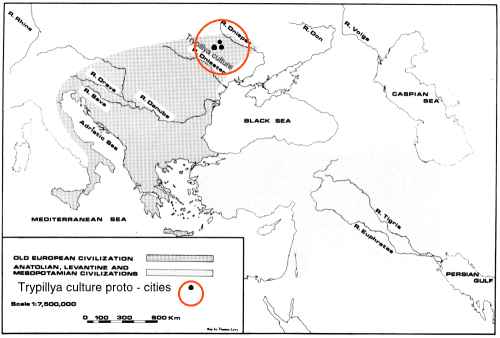
The Old European Civilisation near 5000 BC (after M.Gimbutas,
1973) and Trypillya culture proto – cities.
Into 1984 y. went out a L.Ellis labour, devoted to Cucuteni culture
technologies study problem is Trypillya and origin of complex societies
(Ellis, 1984), to regret almost unknown in Ukraine, if to look on lack
of references on it in articles and editions monographic dis-position.
Interestingly, that into its L.Ellis turn demonstrates kind knowledge of
soviet literature handed into seventies years from problem. In this labour,
for six years before V.Masson (Ìàññîí, 1990), she gave voice to assertion
about complex disposition of Try-pillya society. One of bases for identical
assertions on thought of L.Ellis was existence of enormous settlements
is as proto - cities, capitals old chiefdoms. Judging on references in
other editions stated labor by with M.Gimbutas researches is the basic
source about Trypillya proto - cities for most of European authors.
L.Ellis considered technological and economic subsoil of social
Neolithic processes (Ellis, 1987, p.175 is 191), showing growth of population
quantity, food productions and forming of handicraft centers in Cucuteni
culture are Trypillya. Researches of ceramic production allowed she to
arrive at conclusion about prod-ucts keeping technologies development (Ellis,
1987, y. 180). It con-siders Trypillya society, as distinctly hierarchical.
Its look on large Trypillya settlements said not long ago À. Whittle(
Whittle, 1996). It applied to this theme in prettily synoptic appearance
in tie with question about "steppe threat" (Sredny Stog culture cavalry).
Author thinks, that the enormous settlements had foremost defensive disposition,
attached to this something writes about ditches, which they're not. At
the same timed offered an opin-ion not quite intelligible to us,
that by better rescue from "maraud-ers"(?) was population dispersion,
and not his concentration. But À. Whittle thinks a threat on the part of
steppe tribes unlikely. On his thought somewhat quicker had a place a mutually
beneficial ex-change, and not military opposition. At that it skeptical
treats to set-tlements existence simultaneity - giants on all area, for
they could be diversificated( Whittle, 1996, p.134 - 135).
From references and bibliography visibly, that À. Whittle are unknown the
basic publica-tions on Trypillya proto - cities, because it took information
only from accessible to it from publications of V.Dergachov, E.Chernykh,D.Telegin
and L.Ellis, published in 80- and years. From them only last (Ellis, 1984)relates
in sort to theme, however written with use of materials accessible by then,
when problems, associated from proto - cities, in that number the
questions micro - chronology of sites not yet were explored.
The large settlements of Trypillya culture are mentioned in monograph
of J.Kruk and S. Miliscauscas, which is devoted to rise and fall
of Neolithic agricultural societies (Kruk, Miliscauscas 1999). Into
research base laid down the Poland Neolithic study results - cultures of
Lengyel - Polgar circle, FBC, globular amphorae. Authors compare settlement
of mentioned cultures (especially Bronochice) with Trypillya in aspects
of arhitecture and social significance. Un-der this they apply to more
contemporary articles by V.Kruts and M.Videiko. J.Kruk and S. Miliscauscas
in its monograph write about multi - level hierarchy of Neolithic settlements
on Poland territories. They picked out there "big settlements" (under
this most from them do not arrive at area into 20 hectares), considering
them, as possible centers of chiefdoms (Kruk, Miliscauscas 1999,
s.145, fig.45, s.137 is 146 and oth.).
CONCLUSIONS
Trypillya archaeological culture was discovered by archae-ologists
over age to that. For this time they expressed the thou-sands, and dug
out hundreds of old settlements. Arheometry re-searches gave into hands
of new facts learned to thousand, won under time of researches laboratory
and experimental field,, which eked out a mosaic, laid out by archaeologists
from excavations.
After 30 years of investigations by the medium of magnetic survey
was composed the full or partial plans of a little settlements ten
(all in all by 50), which belongs to different
periods of Trypil-lya culture existence. Was given different
apparatus types try, devel-oped an interpretation methods of got results.
Materials, got under time of these works, widely used by archaeologists
as attached to taking of field researches, so and attached to spelling
of scientific labor. Applications of magnetic survey allowed to heave up
study of settlements of Trypillya culture ( and myself culture, as phenomenon)
on qualitatively new level.
In result of archaeological excavations on extent by 100 years
only in was seen out the explorations considerable for scope more as on
60 settlements of different periods, where explored about
three hundred of different dwellings type, household
com-plexes, etc. For inspections data are
formed the settlements maps.
Analysis of all information cumulative for researches gives
us possible today to tell about Trypillya, as one of most old agricul-tural
European civilizations.
There are two points of view on Trypillya large settlements.
Some archaeologists think, that they appeared on the borders before the
threat of "Steppe invasion". Other thinks, that they appeared as a result
of internal social development, under the threat of wars be-tween Trypillya
culture tribes. The last investigations showed that some inside - cultural
processes (and may be economical and so-cial) in Trypillya were connected
not only with Steppe, but also with Central European cultures.
About arriving at home archaeologists in study to phenome-non Trypillya
proto - cities to little it's known European archaeolo-gists. Such deduction
can be done, looking through bibliography generalizing and even special
labor from problems of European Neolithic. We must note, that similarly
do not read so far in Ukraine articles of western authors, which touched
a problem, which us in-terests. However diffusion process of scientific
information by dint of publications in English (first of all at Baltic
- Pontic Studies ) this problem now gradually decide.
"From Neolithic villages to organized state, from gardening
to irrigation farming, from iconography to writing, from disorganized raids
to institutionalized warfare, from custom to law, from matriarchal religious
authority to patriarchal political power, from mystery to history; the
transformation was so complete that the past itself was reinvented to create
a new foundation for a radically altered present. Now that we ourselves
are moving into a radically altered present, it is small wonder that the
patriarchal image of prehistory is disintegrating. The movement into the
future always involves the revisioning of the past." (Thompson,
1981,p. 208).
Changes in European Prehistory not so radical were and not at
one moment happened.
Evidently, the civilization bases, in that number of urbaniza-tion,
were established in Neolithic. The Researchers studied a cities beginnings
process there, where he was successfully completed - above all things in
Mesopotamia. Here this tradition erect to Chatal-Huyuk. Was spied a row
of urbanization phases in Mesopotamia, where in the second half of fourth
millenium BC the first cities aro-sed. One of urbanization aspects
was a population concentration from small settlements in cities.
It is logically to suppose, that in Early agricultural societies can
take place the like processes. They were related to decision of problems
general for them - by population growth and overpopula-tion,
lack fit for agriculture fields by conflicts between communities. Not nothing
astonishing, that these problems everywhere by like by dint of decided.
Population migrated on new lands, built fortified set-tlements. After trod
a population concentration period in items, breaking the ice of early urbanization.
In Europe, as and in Mesopotamia had a place such an events development
exemplarily at one and the same time is in fifth - fourth millennium
BC. In this case Pre -Indoeuropean settlements with names 'ora?/ura?' endings
and Sumerian "uru-sag" or "mas-ga-na-sag" the similar settlements structures
significated .
In this situation is clear, that terms, corresponding with idea of
such types of settlements, as "town" or "city" in Europe are very
old and, perhaps, reflected real types of settling in V - IV milleniums
BC. Than, the most probably candidates for an -ora? ending are the large
settlements of Trypillya and FBC cultures.
With such point of viewing, the appearance of large settle-ments
in Trypillya-Cucuteni culture one can be considered, as the first urbanization
phase, as one of her possible models.
This process in territory of Ukraine at the beginning of Early Bronze
Age was interrupted. Disappearance of proto-cities was an reflection of
the crisis of extensive agricultural economy.
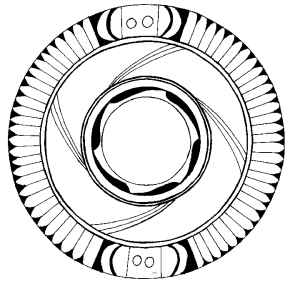
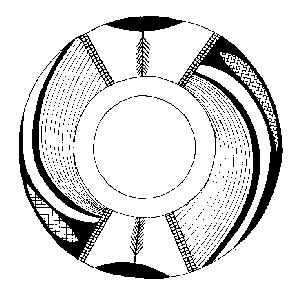
Decoration of painted vessels. Trypillya culture, 3700 – 3500 BC.
Maydanets’ke, Cherkassy domain. Excavations of M.Shmaglij and B.Videiko,
1986.
Ancient East and Europe two ways of civilization develop-ment in IV
Millenia BC showed - growth of first cities and states at Mesopotamia and
temporary closing-down of social progress in some regions of Old Europe.
With like point of viewing on example of Trypillya proto-cities growth
and decline we can study first steps of urbanization, which in other places
by the following development was covered. Therefore we think continuation
of the large Trypillya settlements - proto-cities investigations
in Ukraine may be perspective and interesting.









